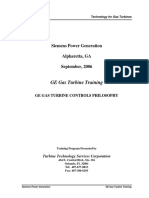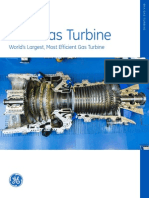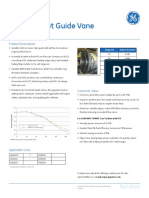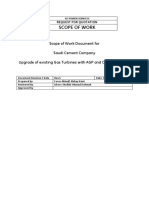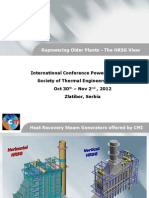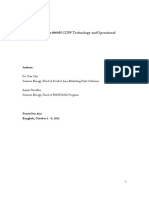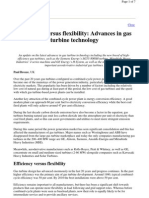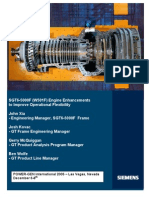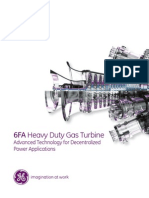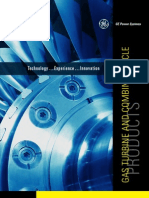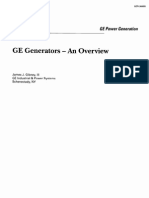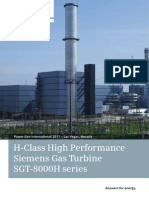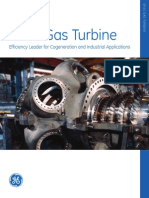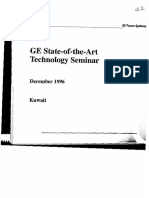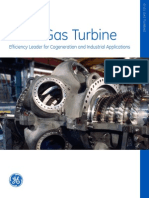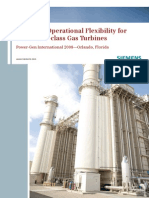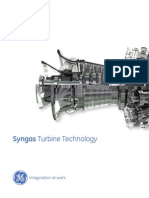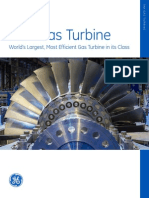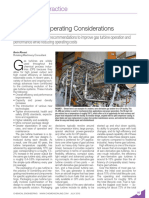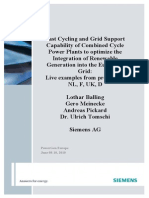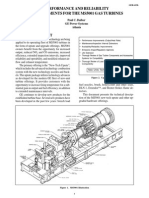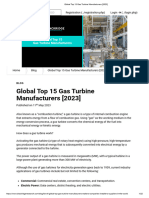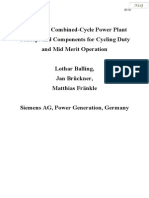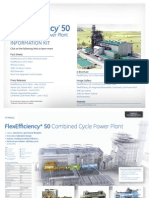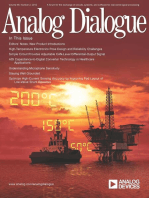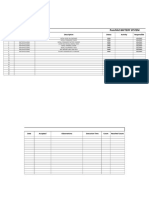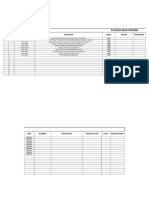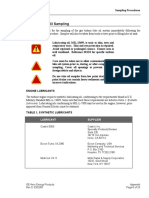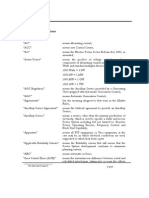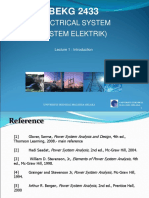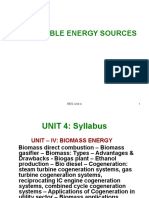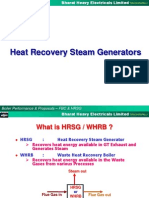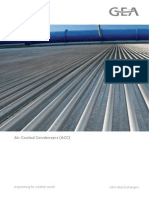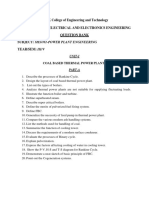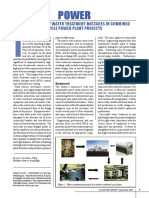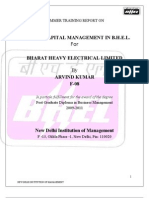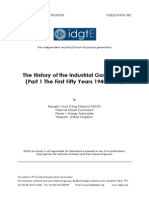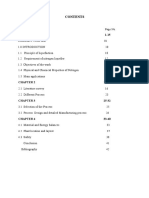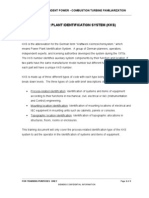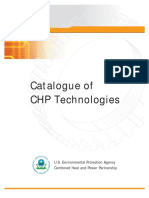Application of The Latest Aeroderivative Gas Turbine Technology
Application of The Latest Aeroderivative Gas Turbine Technology
Uploaded by
DarioOriginal Title
Copyright
Available Formats
Share this document
Did you find this document useful?
Is this content inappropriate?
Report this DocumentCopyright:
Available Formats
Application of The Latest Aeroderivative Gas Turbine Technology
Application of The Latest Aeroderivative Gas Turbine Technology
Uploaded by
DarioCopyright:
Available Formats
09-IAGT 203 1
APPLICATION OF THE LATEST AERODERIVATIVE GAS
TURBINE TECHNOLOGY
Authors: Edward Wacekt, Warren Ferguson, General Electric
*
Abstract—GE Energy has a 40-year history of continuously innovating on its
Aeroderivative gas turbine products to help meet customers needs. Three distinct
platforms have been developed to meet power needs ranging from 18 to 100
megawatts, and have been used in such diverse applications as combined cycle
industrial parks, municipal cogeneration, and remote peak load dispatch. This paper
will review the LM6000 Product Line innovations in the 35-65 MW range. The recent
addition of several innovations on this platform has improved not only their efficiency
but expanded their application suitability.
I. INTRODUCTION
Today’s power industry has had many recent challenges that have changed the way ‘business
is done’. Examples of such challenges include grid systems that are looking to retire older less
efficient and reliable generation, as well as the addition of renewables that further challenge
the characteristics of the grid system. These changes are impacting the thermal generation in
terms of what is needed to support the grid and the operating profile of said generation.
Technology innovation is a key driver to meeting these and other key industry issues.
Aeroderivative gas turbines currently play a key role in providing necessary flexible generation
and are a major component to many operators’ power generating portfolios. Recent
innovations from GE Energy and GE Aviation, from new materials to new designs, has
produced updated products that help to improve the units power and efficiency, and better
position them for a wider range of applications.
In this paper, specific new innovations to the aeroderivative gas turbines in the 35-65 MWe
range will be discussed and how application of these products can improve both system and
plant efficiency. For example, the recent introduction of the LM6000 PG1 offers a 25 percent
simple cycle power increase compared to its predecessor, and its combined cycle power has
increased into the 65 MWe range. The power increase comes from the same 4.5m X 21.5m
package footprint based on existing 50 Hz LM6000 packages. As an example of utilizing the
new technologies into broader applications, the new LM6000 PG has been incorporated into a
2-on-1 reference combined cycle plant that is designed to provide fast, flexible and efficient
135MWe at 52% efficient combined cycle power.
II. TECHNOLOGY OVERVIEW
Since GE began industrializing the CF6-6 aircraft engine in 1971, there has been over $2
billion invested in the aeroderivative product lines that now constitute the GE Energy
Aeroderivative business. Over the course of the past 40 years, GE has advanced the
technology from the original 18MWe LM2500 products that were used on naval warships, to
include 3 distinct product lines that are used on a diverse set of applications such as oil and
gas platforms, to university cogeneration systems, and industrial park combined cycle
installations. These 3 platforms provide customers the opportunity to leverage proven and
General Electric Company Proprietary Information
09-IAGT 203 2
efficient products for their specific project size and application. As investment continues in
each of the platforms, they each have become more globally accepted and utilized in a
diverse set of applications, with the latest technology innovations being no exception. The
latest innovations for the LM6000 are the PG & PH versions of the existing product line.
Denoted as the “PG” for the Standard Annular Combustor (SAC) and “PH” as the Dry Low
Emissions (DLE) model, the gas turbines have 90% common parts to the proven LM6000
family of industrial Aeroderivative gas turbines, but provide more power and better efficiency
in the same footprint. These improvements are being created courtesy of advanced
materials, improved manufacturing process, and minor adjustments in design. Leveraging the
broad experience of GE in gas turbine technology, many of these improvements have been
imported from GE Aviation and the larger GE Energy aeroderivative product, the LMS100.
By utilizing already proven technology, the latest updates to the LM6000 are expected to
maintain comparable reliability numbers as the existing products.
As an example of one of the changes from GE Aviation, the High Pressure Turbine (HPT)
rotor of the LM6000 PG has been modified based on the GE CF6-80E aircraft engine
(common on many Airbus A330 fleets). The LM6000 PC, on the other hand, has a rotor based
on the older GE CF6-80C2 engine. The updated HPT rotor design improvements include new
higher temperature alloys and improved cooling patterns. This switch of rotor effectively
raises the pounds of thrust from 60,000 to 70,000. As a result, the LP compressor can
operate at higher speeds to increase the flow, and the pressure ratio has gone from 30 to 32.
Additional design changes to the HPT rotor include a new bolt pattern between the rotors in
the HPT that has significantly reduced material stresses. On the PC model, the HPT rotor is
the cyclic life limiting part. With the updated material and design advances, the cyclic life was
improved in excess of 40% for the PG model.
Overall the combination of better materials, manufacturing process, and improved cooling
design enables the LM6000 PG to operate at a higher firing temperature. The LP inlet
temperature, for example, has been increased by over 50° C and the compressor discharge
by more than 40° C. These design changes, along with the increased flow through the
engine, allow the gas turbine to run at 3930 RPM v 3600 RPM. This higher RPM is
comparable to the true speed of an aircraft engine.
The net results of these changes are more power with the same or better efficiency within the
same gas turbine footprint. Therefore with the recent introduction of the LM6000 PG & PH
products, its unique new innovations will be highlighted in terms of its use and where the
economic benefit can be seen. Specifically, the application discussion will include:
A. Simple Cycle Enhancements
Having delivered more 35-65MWe gas turbines in simple cycle than any other manufacturer2,
the LM6000 improvements further extends value to customers looking for more power in a
compact plant area. Based on over 17 years of operating data for simple cycle operation,
there is a growing need for gas-fired generation to operate efficiently over a wide spectrum of
ambient temperatures and power ranges. The improvements in the LM6000 provide power
providers the ability to meet this need for a wider operating profile. Additionally, many grid
systems are experiencing frequency fluctuations that can adversely affect power distribution,
even causing back outs. There are several drivers to this, including other generating units
coming off-line, system frequency imbalance, or responding to variable wind or hydro
generation; which causes a change in the interconnected system characteristics. The
LM6000 gas turbine provides power producers an economical means to serve these changing
load requirements.
General Electric Company Proprietary Information
09-IAGT 203 3
B. Proven Cyclic Combined Cycle Generation
Today’s install base of combined cycle plants are experiencing a growing need to operate at
part power, withstand voltage swings, and be capable of faster dispatching. Many of these
market conditions have led to the use of GE Aeroderivative gas turbines to help address
system loads while still addressing efficiency needs. Installations of 2-on-1 and 3-on-1
configurations have increased over the past 15 years to meet variable loads below 200MW.
These systems, when utilizing once-through waste heat recovery systems, provide operators
the flexibility of simple cycle operation in 10 minutes while the steam cycle comes to pressure
and temperature. Additionally, with the once-through design, the integrated system can
withstand cycling to compliment the cyclic capabilities of the gas turbine. Advancements in
plant modularity and system integration are now available that further provide customer
benefits when installing combined cycle Aeroderivative platforms.
C. Supporting Greener Generation
Power generation portfolios are constantly challenged to reduce greenhouse gas emissions.
The LM6000 builds upon its high simple cycle efficiency design to aid efforts by power gen
operators to build greener portfolios. By conserving natural resources with advancements
beyond just the gas generator, the LM6000 GTG positions itself as a cost effective greener
solution in many power gen portfolios.
The following material will demonstrate how the robust heritage of aviation based industrial
Aeroderivatives gas turbines provide a reliable platform with application experience and
technology advancements to meet the diverse needs of the power industry. Several regional
examples will be provided to demonstrate both applications of the units as well as innovation
adoption.
III. SIMPLE CYCLE ENHANCEMENTS
A. Primary power
The need for simple cycle generation has predominantly been driven by peak demand;
however many of today’s units also serve a critical role in maintaining system frequency in
many countries. As the power industry is looking to retire many older inefficient and now
unreliable assets, evaluating unit efficiency and dispatch characteristics are key to addressing
peak demand. Table 1 shows a comparison between unit dispatch, efficiency, and frequency
stabilization for various technologies. A power producer with a complete portfolio of
generation equipment would evaluate which technology to dispatch based on forecasted need
to meet the best economic return. For example, the available coal generation may be cycled
to meet the variable demand, but it requires a substantial advanced notice and is the least
efficient means to do so. System operators may consider dispatching highly efficient
combined cycle units as they require less start-up time, but these units have limited part
power efficiency and turn-down capability should the load not materialize as forecast. The
next most economic alternative may be the open cycle Frame unit as they have more
operational flexibility, at the expense of a less efficient alternative. These factors have led to
the strong adoption of the Aeroderivative gas turbine as an efficient alternative that can swiftly
meet variable load demands.
The recent commissioning of (12) LM6000 units for Kuwait provides an application example
for simple cycle demand. The project required two 200-megawatt plants to be commercially
available in twelve months to meet summer demands. This could be achieved because of the
factory packaging approach that GE employs, where the units are assembled on skids and
General Electric Company Proprietary Information
09-IAGT 203 4
tested at our facility prior to shipment. The package design is both compact and takes into
account maintainability features such as sight drains on lubrication systems, package
mounted removal cranes and access areas. These features also allow for more efficient
shipping of the power plant by utilizing standard shipping industry means of transportation
whether by land or sea. Additionally, the customer team valued the benefit of witnessing the
factory packaging and testing of the units to ensure a rapid site installation and construction
time to meet their schedule.
Coal CCGT OCGT Recip
Fr AD
Ramp rate 8 11 10 50-100 1
(MW/min)
Start cycle 300 30 10-15 10 <10
(min to full load)
Efficiency 33 57 35 43 45
Rotating H H H L L
Inertia
Table 1 Simple cycle alternatives
B. Supporting simple cycle operation – grid stability
The LM6000 platform has incorporated an improved control methodology that enables it to
proactively increase power output in an under-frequency situation. This boost of power, Figure
1, helps to regain the grid frequency and prevent a blackout if grid instability occurs. This
technological advancement utilizes the existing turbomachinery capability and was brought
forth from a new control algorithm in the gas turbines fuel core.
This option is made up of a special control schedule and the communications integration
within LM6000 gas turbine generator sets that provides a more effective, less costly, approach
to achieving stable operation during transient stability upsets. The system will rapidly increase
or decrease unit power output when the owner’s grid or facility management system detects a
severe change in system frequency or loading. The grid stability control system can support
transient upsets in two ways; first, the controls can provide a quick power increase, within
fractions of a second, helps preserve stability and maintain frequency control in transient
situations where there is suddenly too much load connected. Secondly, it can support a rapid
power decrease, while still remaining on line, which helps in situations with sudden large load
reductions, such as tripping of an industrial process or a close-in grid transmission line fault.
Without this option, a generating unit relies on the traditional slower, governor droop control to
react to frequency upsets. Since this option proactively responds to a direct input from the
external high speed plant or power grid monitoring system, and responds more rapidly, a
substantially greater contribution can be made toward preserving stability of the system. This
overpower is done within a control time frame of no more than 15 seconds. This is enough
time for the LM6000 to absorb the transient situation on the grid, yet will not have an adverse
affect on the life of the gas turbine. There is no impact to the standard maintenance intervals
of a LM6000 with this option.
General Electric Company Proprietary Information
09-IAGT 203 5
Figure 1 - Power Increase Above Control Limit
IV. CYCLIC COMBINED CYCLE
Having demonstrated the ability to improve upon the installation of the gas turbine generator
equipment through the use of factory packaging, the same approach has been taken to the
remaining equipment for a Combined Cycle (CC) installation. Several reference combined
cycle plant updates have been developed to aid in the design and construction of a modular
Aeroderivative combined cycle power island. Distinct advantages of the system include
factory packaging of the steam turbine, fast start capability with a dry boiler design, and a
rapid field installation with maximum pre-assembled plant equipment. The reference plant
has been designed with these primary components to ensure maximum flexibility with the
fastest start-time, part power efficiency, and cyclic capabilities.
The aforementioned advancement to the GE LM6000 gas turbine product line brings an 18%
increase in the exhaust energy and 25% increase in power; which in the combined cycle
configuration makes the reference 2-on-1 LM6000 capable of providing 135MWe net power at
52% efficiency. Efficiency can reach as high as 56% using GE’s Dry Low Emission (DLE)
technology, but the power output will be slightly less. Additional output can be added to the
plant through duct firing.
The modular approach to a 2-on-1 LM6000 CC plant centers around a power island with 2
LM6000 Gas Turbine Generator (GTG) sets, 2 Once Through Steam Generator (OTSG), and
1 skid mounted Steam Turbine Generator (STG). Recognizing that each site location will
require unique considerations, the power island reference plant materials are offered as an
Engineered Equipment Package (EEP), and is used for a basis to guarantee plant output and
heat rate when adhered to, regardless of the role GE has in the procurement and construction
phase of the project.
The LM6000 reference plant will have options, including different LM6 engine configurations,
BOP adders like chilling, or the ability to dry cool the major components around the plant. A
regional example of utilizing various options has been the country of Turkey. The installations
of the LM6000 has been growing in Turkey since the mid 1990’s, from applications ranging
General Electric Company Proprietary Information
09-IAGT 203 6
from summer peaking to industrial park combined cycle plants. Recently a 2-on-1 LM6000 PC
plant going into Burdur, Turkey followed the reference power island design. Like the reference
plant in Figure 2, the facility will use once through boilers and dry secondary cooling to
minimize water usage and maximize flexibility.
Figure 2 - GE 2-on-1 Reference Plant
Proven benefits from existing 2-on-1 LM6000’s in combined cycle have been full power in 45
minutes or less. Additionally, other benefits include improved part power efficiency, and the
ability to cycle the CC plant without a maintenance cost increase. Based on existing
experience a LM6000 CC reference plant has been developed to show a potential Installation
and Commissioning (I&C) cycle time of 24 months, including time for engineering design and
product delivery. Benefits of a modular construction design include reduced development
time, reduced installations costs, and reduced risk.
V. SUPPORTING GREENER GENERATION
In the U.S., although the cost of wind energy is becoming increasingly competitive with other
power generation such as natural gas and coal, it has penetrated less than 1 percent of U.S.
generated electricity. However, it has been stated that wind energy could one day supply up to
20 percent of the United State's power. In Europe the targets for wind power growth are
substantial. Wind is projected to deliver 33 percent of all new electricity generation capacity
and provide electricity for 86 million Europeans by 20103.
A. Wind Firming
Despite increasing momentum towards wind power globally, wind cannot supplant baseload
generation over the long term. On a hot summer day when customer demand is at its
maximum, wind availability may be limited. Therefore, where wind works best is when it is
matched with a controllable peaking power source like natural gas combustion turbines, which
can be ramped up or down to respond to the varying loads inherent in wind farms4.
With increases in wind power in many power generation portfolios, the need to stabilize the
power onto the grid has proven a need for supporting power generation with operational
flexibility5. Wind power in general has a major contribution during low load hours, but only a
small contribution during peak hours. Additionally, wind itself can be intermittent. The
General Electric Company Proprietary Information
09-IAGT 203 7
LM6000’s quick start and grid stability controls makes for a stabilizing effect on the grid.
Additionally, with the necessity for quick and frequent starts/stops to support the variable
generation, the Aeroderivative technology can cycle from on to off, on to part load, and from
full load down to spinning reserve to meet the variable demand.
Also to support quick and frequent starts/stops, the LM6000 standard 10 minutes start time
can be improved to just 5 minutes. The 10-min start is outlined in Figure 3, and shows the
sequence that includes purge time, warm-up time, and finally gas turbine ramp time. By
properly maintaining the package purge requirements, and by keeping the lube oil ‘warm’,
approximately 2 minutes can be removed from the 10-min start sequence. Then the gas
turbine acceleration rate to full load can be increased from 12MW/min to 50MW/min, reducing
the time from sync idle to full load from 4 minutes down to approximately 1 minute. This
reduced start time greatly enhances the LM6000’s ability to get online quickly to support a
reduction in load from the wind farm due to sudden changes in wind conditions.
Turbine Warm-up Includes
synchronization Full
12000
and breaker closure Load
10000
LM6000 HPC Speed - (rpm)
8000
Ramp to Full
6000
Ignition & ramp to Load
Engine &
synchronous idle ~12MW/min
Stack Purge
4000
2000
0 100 200 300 400 500 600 700
Time (Sec)
Figure 3 – LM6000 Ten-Minute Start
Once online, the Aeroderivative technology can utilize its aircraft engine heritage and throttle
up and down to follow the wind firming demands. Figure 4 shows a typical LM6000 in a load
following application. The LM6000 can adjust from sync idle to full load in under a minute, as
well as make adjustments to load variation requirements in seconds. A key for the GTG life
management tracking is an accurate count of cycles, and the LM6000 has built-in cyclic count
tracking in the package software.
General Electric Company Proprietary Information
09-IAGT 203 8
50
45
40
35
Output (MW)
30
25
20
15
10
5
0
7/1 1 7/12 7/ 13 7/14 7/15 7/16 7/17 7 /18 7/19 7/20
50 00:00 00:00 0 0 :00 00:00 00:00 00:00 00:00
20 0 8 (1 m inu te in te rvals )
00 :00 00:00 00:00
45
40
35
Output (MW)
30
25
20
15
10
5
0
7/17 7/1 7 7 /1 7 7 /1 7 7/17 7/17 7/17 7 /1 7 7 /1 8
00 :00 0 3:00 0 6:0 0 0 9:0 0 12 :00 15 :00 1 8:00 2 1:0 0 0 0:0 0
20 08 (1 m inu te in terv als)
Figure 4 - LM6000 in load following mode
The wind firming benefits are standard feature to a LM6000 gas turbine, and thus do not
affect the planned maintenance schedule (based on fired hours) or have an adverse effect on
maintenance cost. There are additional cyclic counts added to the cyclic limited components
of the gas turbine, but current standards on cyclic duty for the existing LM6000 products are in
excess of 6400 cycles. In addition, the design changes on the PG/PH have extended the
cyclic life of the gas turbine by 40%. This makes for a good fit into wind power generation
support.
B. Water
Another advancement in the controls of a gas turbine is in the use of water. For the LM6000,
water can be used for both NOx reduction and power augmentation. Most often the
discussion on gas turbine efficiency is based on fuel consumption (heat rate, efficiency), but
with many global water scarcity issues, the efficient use of water can be a critical operating
profile consideration. An updated control algorithm in the fuel core manages water usage for
maximum efficiency for preset conditions such as NOx output, power output, and grid
frequency.
For a Single Annular Combustor (SAC) LM6000 model, water usage can be up to 13,400 l/hr
during full load operation (not including any water used for cooling or inlet conditioning around
the package). This water usage amount accounts for NOx abatement and for a power
augmentation option called SPRINT®. Roughly 2/3 of the water consumption is for NOx
abatement, and the rest is used for SPRINT®. In the control system, the water table algorithm
controls water usage during key transitions of the gas turbine where excess water could be
consumed. Such transitions include ramping up to full power, part power operation, and
SPRINT® operation turning on/off. Figure 5 has an example of SPRINT utilization running the
gas turbine at part power.
General Electric Company Proprietary Information
09-IAGT 203 9
Variable SPRINT Load Step Engine Test Results
% Max
Power
Std SPRINT water usage:
SPRINT 2597 liters
Flow
Variable SPRINT water Usage:
1688 liters
0 36
Minutes Time Minutes
®
Figure 5 – Variable SPRINT
As mentioned, plant efficiency analyses on operating costs are starting to analyze water
consumption as well as fuel consumption. The example shown in Figure 5 represents a 35%
decrease in water usage for SPRINT®. If a plant operation profile includes constant starts and
stops, as well as part power operation, the savings in water can be substantial. Additionally,
with improved water optimization at part power comes improved fuel efficiency seen through
improved heat rate of the gas turbine. All this leads to improved operating costs for the
power producer.
VI. CONCLUSIONS
The results of applying many decades of technology from the GE Aviation business to
industrial applications has provided customers of the GE Aeroderivative products a robust,
efficient, and reliable product. The innovation continues with expanded reach and
development, and the innovative technologies have been applied to not only the gas turbine,
but to all aspects of the power plant; from packaging design to product application. The power
generation market is going through substantial changes at this time and operational flexibility
is a key for power generators to maximize profitability and still provide meet customer
satisfaction goals. By utilizing Aeroderivative gas turbines, many power providers are finding
new ways to profit from a proven technology. The LM product lines have withstood many
market cycles, and the investments being made today ensure it will provide customers many
benefits for years to come.
General Electric Company Proprietary Information
09-IAGT 203 10
References
1. PowerGen Europe launch, http://www.gepower.com/about/press/en/2008_press/060408b.htm
2. McCoy Power Reports, 2009
3. http://ge.ecomagination.com/products/wind-turbines.html
4. Wind Power Integrates with Natural Gas Plant at Emporia Energy Center Peaking Facility, Ramona
Vassar, RMEL Electric Energy, Fall 2009
5. Advantages of Flexible Thermal Generation in High Wind Penetration Grids, Nicholas Miller, VGB
Konferenz Kraftwerke, April 2009
t edward.wacek@ge.com
The information contained in this document is General Electric
Company proprietary information and is disclosed in confidence. It is
the property of General Electric and shall not be used, disclosed to
others, or reproduced without the express written consent of
General Electric. If consent is given for reproduction in whole or in
part, this notice and the notice set forth on each page of this
document shall appear in any such reproduction in whole or in part.
The information contained in this document also may be controlled
by the U.S. export control laws. Unauthorized export or re-export is
prohibited.
General Electric Company Proprietary Information
You might also like
- GE Gas Turbine Training Manual PDFDocument290 pagesGE Gas Turbine Training Manual PDFmehrzad rahdar100% (16)
- GE 9HA Gas TurbineDocument4 pagesGE 9HA Gas Turbinejparmar100% (1)
- 5 Development and Operating Experience PDFDocument10 pages5 Development and Operating Experience PDFVijaya100% (4)
- Energy Storage: Legal and Regulatory Challenges and OpportunitiesFrom EverandEnergy Storage: Legal and Regulatory Challenges and OpportunitiesNo ratings yet
- Fact Sheet Variable Inlet Guide VaneDocument1 pageFact Sheet Variable Inlet Guide VaneDario100% (2)
- Shell Gasification ProcessDocument31 pagesShell Gasification ProcessOwumi IkomiNo ratings yet
- EPC Scope REV 6Document29 pagesEPC Scope REV 6Anonymous uLAATWpfNo ratings yet
- Cmi - The View of The HRSG.Document32 pagesCmi - The View of The HRSG.Pajoohesh100% (2)
- Aeroderivative Technology PDFDocument10 pagesAeroderivative Technology PDFabhaymehta67No ratings yet
- SCC5-8000H 1S Irsching 4 On The Way To 60% World Record: Answers For EnergyDocument16 pagesSCC5-8000H 1S Irsching 4 On The Way To 60% World Record: Answers For EnergyUhrin Imre100% (1)
- 4 Fast Cycling CapabilityDocument13 pages4 Fast Cycling CapabilityktsnlNo ratings yet
- One Year of Commercial Operation in Irsching PDFDocument33 pagesOne Year of Commercial Operation in Irsching PDFmyegnrNo ratings yet
- Efficiency Versus Flexibility: Advances in Gas Turbine TechnologyDocument7 pagesEfficiency Versus Flexibility: Advances in Gas Turbine TechnologyDai HaizhongNo ratings yet
- 2 Introducing The SGC65000F PDFDocument16 pages2 Introducing The SGC65000F PDFpalash11No ratings yet
- Ger 4222a New High Efficiency Simple Cycle Gas Turbine Lms100Document20 pagesGer 4222a New High Efficiency Simple Cycle Gas Turbine Lms100raghavendran raghuNo ratings yet
- Siemens - SGT6-5000F (W501F) Engine Enhancements To Improve OpDocument14 pagesSiemens - SGT6-5000F (W501F) Engine Enhancements To Improve OpparatonerqNo ratings yet
- GE LMS100 World Power Briefing Systems (May 2010) PDFDocument4 pagesGE LMS100 World Power Briefing Systems (May 2010) PDFAnonymous PkeI8e84RsNo ratings yet
- Advanced Sgt6-5000F Development: 09-IAGT-202Document18 pagesAdvanced Sgt6-5000F Development: 09-IAGT-202Ronald ChavezNo ratings yet
- 6FA HDGT Product Brochure-GEA17987Document8 pages6FA HDGT Product Brochure-GEA17987mike100% (2)
- Ger4250 LM2500G4Document12 pagesGer4250 LM2500G4Denis JimenezNo ratings yet
- TRB 0112 24Document2 pagesTRB 0112 24nickchoNo ratings yet
- Gasturbine sgt5 8000h H Klasse Performance PDFDocument10 pagesGasturbine sgt5 8000h H Klasse Performance PDFAbd Elrahman HamdyNo ratings yet
- Technology Experience Innovation: GE Power SystemsDocument20 pagesTechnology Experience Innovation: GE Power SystemsLegwanOPOLE100% (4)
- Low Load Operational Flexibility For Siemens Gas Turbines PDFDocument17 pagesLow Load Operational Flexibility For Siemens Gas Turbines PDFHeitor José Tessaro100% (1)
- Generator Cooling MethodsDocument16 pagesGenerator Cooling MethodsKVV100% (1)
- H Class High PerformanceDocument10 pagesH Class High Performancekoohestani_afshin100% (1)
- Ge 6F.01 PDFDocument4 pagesGe 6F.01 PDFkangsungjin100% (1)
- Ge Power Ststem Manuals PDFDocument157 pagesGe Power Ststem Manuals PDFveejai_kumar100% (3)
- 6f01 Fact SheetDocument4 pages6f01 Fact SheetmikeNo ratings yet
- USC Steam Turbine TechnologyDocument17 pagesUSC Steam Turbine TechnologyteijarajNo ratings yet
- Low Load Operational Flexibility For Siemens G-Class Gas TurbinesDocument17 pagesLow Load Operational Flexibility For Siemens G-Class Gas TurbinesthryeeNo ratings yet
- F646 CompleteSampleDocument36 pagesF646 CompleteSampleJohn SmeethNo ratings yet
- Syngas Turbine TechnologyDocument12 pagesSyngas Turbine TechnologyJunsung KimNo ratings yet
- GE H ClassDocument5 pagesGE H Classlink2u_007No ratings yet
- Gas TurbineDocument31 pagesGas TurbineŞansal Dikmener100% (1)
- 7HA Gas Turbine: World's Largest, Most Efficient Gas Turbine in Its ClassDocument4 pages7HA Gas Turbine: World's Largest, Most Efficient Gas Turbine in Its Classjparmar100% (2)
- Gas Turbines - Design and Operating ConsiderationsDocument5 pagesGas Turbines - Design and Operating ConsiderationsaliNo ratings yet
- 1 Syngas Capable PDFDocument8 pages1 Syngas Capable PDFoverlord5555No ratings yet
- CCPP Cycling PDFDocument20 pagesCCPP Cycling PDFStefanos GabalacNo ratings yet
- CatalogoTurbineaGas PDFDocument34 pagesCatalogoTurbineaGas PDFshihabjamaan50% (2)
- GE Gasturbine CC ProductsDocument27 pagesGE Gasturbine CC Productstiarariestya100% (1)
- The 9f PlatformDocument8 pagesThe 9f Platformsevero97No ratings yet
- Advantages of Aeroderivatives IAGT 206 - Final - PaperDocument15 pagesAdvantages of Aeroderivatives IAGT 206 - Final - PapermvanzijpNo ratings yet
- MS5001 GuideDocument39 pagesMS5001 GuidekLARA DIVINO100% (6)
- 9ha 01 - 02Document2 pages9ha 01 - 02Ubair KaziNo ratings yet
- Global Top 15 Gas Turbine Manufacturers (2023)Document22 pagesGlobal Top 15 Gas Turbine Manufacturers (2023)Venkat Madhav ModugaNo ratings yet
- Components of Cycling - CCPP - SiemensDocument14 pagesComponents of Cycling - CCPP - SiemensKenshin HimuraNo ratings yet
- Flex Efficiency 50 CC Plant Information KitDocument45 pagesFlex Efficiency 50 CC Plant Information KitAzfar Javaid100% (1)
- CEP - SavingDocument6 pagesCEP - SavingManoj UpadhyayNo ratings yet
- Siemens Syngas Capable TurbinesDocument8 pagesSiemens Syngas Capable TurbinesAlasdair McLeodNo ratings yet
- The Fall of The F-Class TurbineDocument6 pagesThe Fall of The F-Class Turbinechdi100% (1)
- Energy and Thermal Management, Air-Conditioning, and Waste Heat Utilization: 2nd ETA Conference, November 22-23, 2018, Berlin, GermanyFrom EverandEnergy and Thermal Management, Air-Conditioning, and Waste Heat Utilization: 2nd ETA Conference, November 22-23, 2018, Berlin, GermanyChristine JuniorNo ratings yet
- Gas-Engines and Producer-Gas Plants A Practice Treatise Setting Forth the Principles of Gas-Engines and Producer Design, the Selection and Installation of an Engine, Conditions of Perfect Operation, Producer-Gas Engines and Their Possibilities, the Care of Gas-Engines and Producer-Gas Plants, with a Chapter on Volatile Hydrocarbon and Oil EnginesFrom EverandGas-Engines and Producer-Gas Plants A Practice Treatise Setting Forth the Principles of Gas-Engines and Producer Design, the Selection and Installation of an Engine, Conditions of Perfect Operation, Producer-Gas Engines and Their Possibilities, the Care of Gas-Engines and Producer-Gas Plants, with a Chapter on Volatile Hydrocarbon and Oil EnginesNo ratings yet
- Innovation Landscape brief: Utility-scale BatteriesFrom EverandInnovation Landscape brief: Utility-scale BatteriesNo ratings yet
- Process System Value and Exergoeconomic Performance of Captive Power PlantsFrom EverandProcess System Value and Exergoeconomic Performance of Captive Power PlantsNo ratings yet
- Ejectors for Efficient Refrigeration: Design, Applications and Computational Fluid DynamicsFrom EverandEjectors for Efficient Refrigeration: Design, Applications and Computational Fluid DynamicsNo ratings yet
- Electricity Storage and Renewables Cost and Markets 2030From EverandElectricity Storage and Renewables Cost and Markets 2030No ratings yet
- Fueling Healthy Communities V1 Energy Storage Secure Supplies Whitepaper: POWER TO GAS ENERGY STORAGEFrom EverandFueling Healthy Communities V1 Energy Storage Secure Supplies Whitepaper: POWER TO GAS ENERGY STORAGENo ratings yet
- Reducing Business Jet Carbon Footprint: Using the Power of the Aircraft Electric Taxi SystemFrom EverandReducing Business Jet Carbon Footprint: Using the Power of the Aircraft Electric Taxi SystemNo ratings yet
- Offshore Wind Energy Generation: Control, Protection, and Integration to Electrical SystemsFrom EverandOffshore Wind Energy Generation: Control, Protection, and Integration to Electrical SystemsNo ratings yet
- Energy Storage in Grids with High Penetration of Variable GenerationFrom EverandEnergy Storage in Grids with High Penetration of Variable GenerationNo ratings yet
- Cca Battery System PunchlistDocument2 pagesCca Battery System PunchlistDarioNo ratings yet
- Punchlist Unit 100 Water Injection: Number Area Description Status Activity ResponsibleDocument2 pagesPunchlist Unit 100 Water Injection: Number Area Description Status Activity ResponsibleDarioNo ratings yet
- Cca Medium Voltage PunchlistDocument2 pagesCca Medium Voltage PunchlistDarioNo ratings yet
- Punchlist HIGH VOLTAGE: Number Area Description Status Activity ResponsibleDocument2 pagesPunchlist HIGH VOLTAGE: Number Area Description Status Activity ResponsibleDarioNo ratings yet
- Punchlist Item Remediation Record: As FoundDocument1 pagePunchlist Item Remediation Record: As FoundDarioNo ratings yet
- LM6000 Sampling Procedure With SpecificationsDocument18 pagesLM6000 Sampling Procedure With SpecificationsDario100% (1)
- 15.16 LM6000 Start-Up and Commissioning Spares: P/N Description QtyDocument9 pages15.16 LM6000 Start-Up and Commissioning Spares: P/N Description QtyDarioNo ratings yet
- 09 - IGV System PDFDocument4 pages09 - IGV System PDFDario100% (1)
- Nigeria Grid CodeDocument65 pagesNigeria Grid CodeAyoade Lanre BexNo ratings yet
- L1 BEKG2433 Power SystemDocument40 pagesL1 BEKG2433 Power SystemAmeer KhanNo ratings yet
- Renewable Energy Sources: RES Unit 4 1Document50 pagesRenewable Energy Sources: RES Unit 4 1sibirajNo ratings yet
- Overview Heat Recovery Steam GeneratorsDocument94 pagesOverview Heat Recovery Steam Generatorsjrri1680% (5)
- Vijay Resume QECDocument6 pagesVijay Resume QECeimanoNo ratings yet
- Power Plant O&M: How Does The Industry Stack Up On Cost?: Gas Turbine ($20 Per KW)Document3 pagesPower Plant O&M: How Does The Industry Stack Up On Cost?: Gas Turbine ($20 Per KW)John WhallyNo ratings yet
- IRENA Geothermal Power 2017Document28 pagesIRENA Geothermal Power 2017siyagNo ratings yet
- Ansaldo EnergyDocument46 pagesAnsaldo Energysertackcdg100% (2)
- Brochure Air Cooled CondenserDocument8 pagesBrochure Air Cooled CondenserFathur Rahman Handoko100% (1)
- Arul 3 Years - ExpDocument9 pagesArul 3 Years - ExpsvrsamroseNo ratings yet
- Power Plant Engineering Question BankDocument10 pagesPower Plant Engineering Question Bankramaprasad1967100% (2)
- Water Treatment CCPPDocument7 pagesWater Treatment CCPPtsrinivasan5083100% (1)
- CatalogoTurbineaGas PDFDocument34 pagesCatalogoTurbineaGas PDFshihabjamaan50% (2)
- Summer Training Report On WCM For BHELDocument65 pagesSummer Training Report On WCM For BHELArvind KumarNo ratings yet
- GT PresentaionDocument98 pagesGT Presentaionmujeebtalib100% (6)
- GE's New Gas Turbine System: Designed To Change The Game in Power GenerationDocument12 pagesGE's New Gas Turbine System: Designed To Change The Game in Power GenerationHeryanto SyamNo ratings yet
- Gas Turbine Operation & Maintenance CourseDocument100 pagesGas Turbine Operation & Maintenance Coursewaheed2286100% (4)
- Customer Course CatalogDocument117 pagesCustomer Course CatalogAlaa AdnanNo ratings yet
- Sabah Electricity Supply Industry Outlook 2015Document62 pagesSabah Electricity Supply Industry Outlook 2015fivanada100% (1)
- Policy For CaptiveDocument17 pagesPolicy For CaptiveRamesh AnanthanarayananNo ratings yet
- IDGTE Paper 582Document50 pagesIDGTE Paper 582Dan TalmaciuNo ratings yet
- ME6701-Power Plant EngineeringDocument10 pagesME6701-Power Plant EngineeringSiva KumarNo ratings yet
- Documnt ProjectDocument47 pagesDocumnt ProjectChandu Chandra Sekhar100% (1)
- 02 KksDocument8 pages02 KksManuel Jesus Perez MelgarNo ratings yet
- Asad ResumeDocument3 pagesAsad ResumeAsad AliNo ratings yet
- Organic Rankine Cycle Power PlantDocument6 pagesOrganic Rankine Cycle Power PlantPower PowerNo ratings yet
- Catalogue of CHP Technologies: U.S. Environmental Protection Agency Combined Heat and Power PartnershipDocument150 pagesCatalogue of CHP Technologies: U.S. Environmental Protection Agency Combined Heat and Power Partnershipschraz4575No ratings yet
